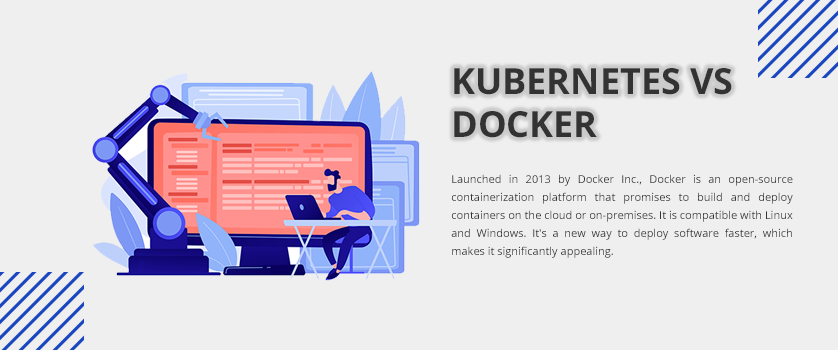


Launched in 2013 by Docker Inc., Docker is an open-source containerization platform that promises to build and deploy containers on the cloud or on-premises. It is compatible with Linux and Windows. It's a new way to deploy software faster, which makes it significantly appealing.
With Docker, you can streamline the process of creating containers with the help of tools like Docker file and Docker compose. It also helps developers to move their workload from their local environment to the cross platforms and reduce dependency that results in faster delivery of the software with improved quality.
|
Pros |
Cons |
|
|
As developers started to build and deploy containerized applications using container technology, they witnessed massive growth, which led to the breaking down of traditional practices and put microservices upfront for easy resource optimization and low-cost infrastructure maintenance. However, organizations felt that the rising number of container usage created various challenges while managing and deploying them.
Then came Kubernetes, an open-source project developed by Google in 2014. It’s a container orchestration platform that allows users to define the desired state of their container architecture deployment in various environments. It takes input from the user and deploys and manages multi-container applications across multiple hosts while maintaining the desired state of these hosts. Kubernetes brought this revolution while using containers and created a framework for features like scalability, monitoring, and cross-platform deployments.
|
Pros |
Cons |
|
|
No doubt that both Docker and Kubernetes are two incredible platforms but the comparison between them is not just. Why? Because both are designed to serve a different purpose and can’t be replaced. While Docker helps you create containers, Kubernetes assists you to manage those containers.
However, if you still want to compare two platforms, it should be Kubernetes and Docker Swarm, as they both are container orchestration tools. Since Docker Swarm is built by Docker Inc., people, unknowingly, compare Kubernetes with Docker instead of Docker Swarm.
Both tools are container management tools but offer different sets of features. In the following table, you can find out how they are different from each other.
|
Kubernetes |
Docker Swarm |
|
|
Installation and Cluster |
If you are installing Kubernetes in a smaller configuration environment then it won’t be difficult but if you want to scale it further, it requires more planning and effort. And to do so much planning, you need to run separate steps for each function like:
|
Docker Swarm uses Docker CLI. Since here you need a single set of tools to run those commands to build the environment and configure, you don’t need to follow many steps, as Swarm programs run into your current docker. |
|
Building and Running Containers |
Kubernetes has its own API, client, and YAML definition. If you compare these to Docker Swarm you will find that Kubernetes has more to offer when it comes to defining containers. |
To build new containers Docker CLI is used, though Swarm supports multiple tools that work with Docker, yet it could be a hassle if you want to perform specific operations in Docker. |
|
Logging and Monitoring |
Kubernetes has some inbuilt tools for logging and monitoring. Logging lets users understand the case of failure by seeing the past records or logs. Contrary, monitoring enables users to constantly check the health of nodes and services that are containerized by these nodes. |
Docker Swarm does not have inbuilt tools to handle tasks such as logging and monitoring. However, you can take advantage of the third-party tools to perform these tasks. |
|
Scalability |
To maintain the strength of the clusters, Kubernetes is the best choice as compared to Swarm. However, it is not easy to scale with Kubernetes because of the complexity its APIs produce. Also, its strong focus on the cluster states makes it difficult for the users. But when it comes to autoscaling it is way better than Swarm as it can automatically analyze the server load and adjust with your requirements. |
Docker Swarm is known to perform scalable tasks better than Kubernetes. Swarm containers can be deployed faster when it comes to handling large clusters. To deploy new replicas of containers, you need to run a single command. On the other hand, it also allows auto-scale as smoothly as Kubernetes. |
|
GUI |
If you are comfortable working with dashboards then you will love Kubernetes because its GUI provides a reliable dashboard that can be used to control the cluster. Even if you are not from a technical background you can use it easily because it provides simple and plain instructions. |
Docker Swarm doesn’t have its dashboard to manage clusters but you can use third-party tools like Portainer.io that provide good UI. |
|
Load Balancing |
In Kubernetes, load balancing is permitted when container pods are defined as services. Besides this, you need to manually configure these settings, and only a certain set of pods and policies give access to each service. |
In Docker Swarm, there are inbuilt facilities for load balancing, where a common network joins all containers that are in the same clusters. This way it allows the connection of any node to any container. |
Both Kubernetes and Docker are different technologies that are built to perform specific tasks. However, you can compare Docker Swarm and Kubernetes as both are container orchestration tools. But to pick one over the other is really difficult because both tools are equipped with distinct features, yet they have one thing in common: they both help your organization to transform digitally.